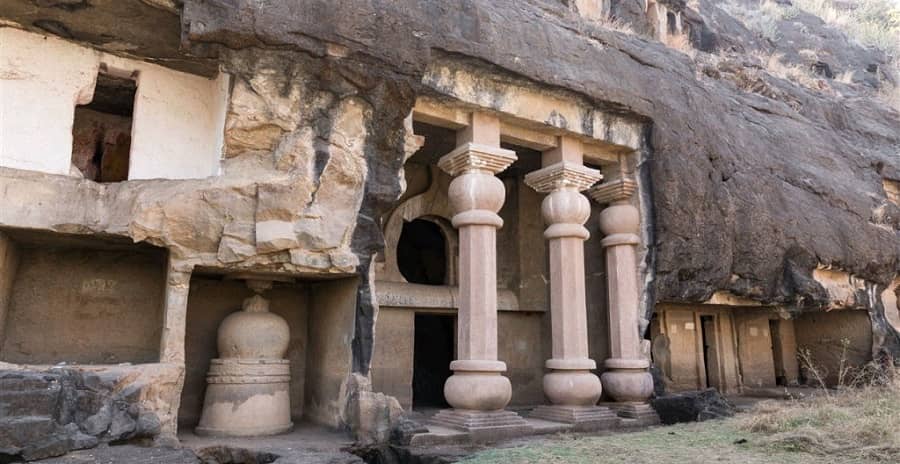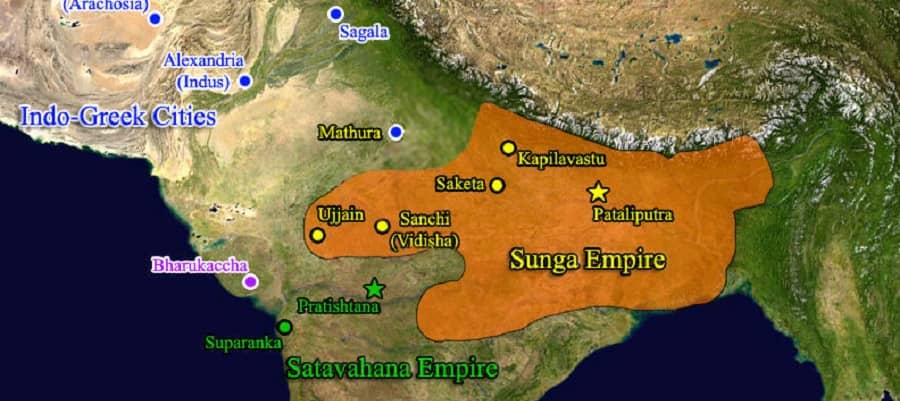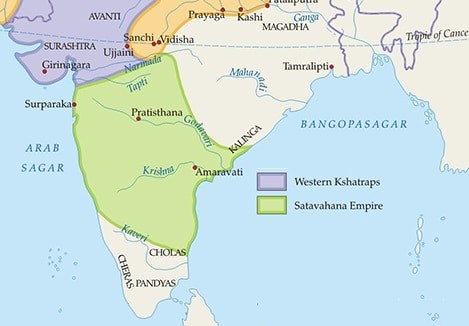Contents
Satavahana dynasty Sunga dynasty
Satavahana dynasty Sunga dynasty
- Kalinga declared its independence & in further south Satavahana dynasty declared their independent rule.
- As a result, the Mauryan empire was confined to Gangetic valley & soon replaced by Sunga dynasty.
>>>>>>>>>>
>>>>>>>>>>>
Sunga Dynasty (185 – 73 BC)
Pushyamitra Sunga (185 – 151 BC)
- Pushyamitra Sunga was a Brahmin army chief of Brihadratha, the last king of the Mauryas.
- During a military parade, he killed Brihadratha and established Sunga dynasty in 185 or 186 BC.
- According to some historians, this was an internal revolt against the last Mauryan king.
- Some say it was a Brahminical reaction to the Mauryan overwhelming patronage of Buddhism.
- Pushyamitra Sunga’s capital was at Pataliputra.
- He successfully countered attacks from two Greek kings namely, Menander and Demetrius.
- The drama Malavikaagnimitram mentions the victory of Pushyamitra over Yajnasena, the king of Vidarbha
- He also thwarted an attack from the Kalinga king Kharavela.
- Pushyamitra sunga built the sculptured stone gateway at Sanchi.
- He performed two Ashvamedha, Rajasuya and Vajapeya, as mentioned in the Ayodhya stone inscription of King Dhana.
- Pushyamitra Sunga patronised the Sanskrit grammarian Patanjali, who wrote the Mahabhasya.
- The Divyavadana gives an account of Pushyamitra’s cruelty towards Buddhists and Buddhism.
>>>>>>>
Agnimitra (149 – 141 BC)
- Agnimitra is the hero of Kalidasa’s poem, Malavikagnimitram.
- His son Vasumitra succeeded him as king.
>>>>>>>>>
Bhagabhadra/Bhagavata
- We can get his account from Besnagar Pillar inscription of Heliodorus.
- Heliodorus was the Greek Ambassdor of the Indo-Greek ruler Amtalakita/Antialkidas of Taxila
- He stayed at Sunga dynasty court.
>>>>>>>>>>>
Devabhuti
- He also known as Devabhumi and was the last ruler of the Sunga Dynasty.
- According to the Harschcharita, he was killed by his Brahmana minister Vasudeva Kanva, who founded the Kanva dynasty.
>>>>>>>
Effects of Sunga Dynasty Rule
- Hinduism was revived under the Sunga dynasty.
- The caste system was also revived with the rise of the Brahmanas.
- Another important development was emergence of various mixed castes and the integration of foreigners into Indian society.
- The language of Sanskrit gained more prominence during this time.
- Even some Buddhist works of this time were composed in Sanskrit.
- There was an increase in the usage of human figures and symbols in art during the period of Sunga dynasty.
>>>>>>>>>>>
>>>>>>>
Kanva Dynasty (73 – 28 BC)
- Devabhuti was killed by his own minister, Vasudeva Kanva in around 73 BC.
- Vasudeva Kanva established the Kanva dynasty at Magadha from 73 to 28 BC.
- Vasudeva Kanva supposed to be a descendent of Rishi Kanva and ruled from Pataliputra.
- Kanva dynasty ruled for approx. 45 years.
- According to some scholars, the last Kanva ruler Susharman was overthrown by a successor of Simuka of the Satavahana dynasty.
>>>>>>>>>>>
>>>>>>>>>>>
Chedi Dynasty of Kalinga
- The Cheti or Chedi dynasty emerged in Kalinga in the 1st century BC.
- The Hathigumpha inscription (Udaigiri hills) situated near Bhubaneswar gives information about it.
- This inscription was engraved by king Kharavela who was the 3rd Cheti king.
- Kharavela was a follower of Jainism.
- Other ruler names of this dynasty are Cheta or Chetavamsa, and Mahameghavahana.
>>>>>>>>>>>
>>>>>>>>>>>
Satavahana Dynasty (235 BC-200 CE)
- Satavahana dynasty rules is believed to have started in 235 BC and lasted until the 2nd century AD.
- The Satavahana dynasty succeeded the Mauryas in the south, though after a gap of almost 100 years.
- They are referred to as Andhras in the Puranas.
- Pratishthana (Paithan) and Amaravati were its capitals.
- The Satavahana kingdom comprised of modern-day Andhra Pradesh, Telangana and Maharashtra, parts of Karnataka, Gujarat and Madhya Pradesh.
- Their greatest competitors were the Shaka Kshatrapas of Western India
- They were the first native Indian rulers to issue their own coins with the portraits of the rulers.
- This practice was started by Gautamiputra Satakarni who derived the practice from the Western Satraps after defeating them.
- The coin legends were in Prakrit language.
- Some reverse coin legends are in Telugu, Tamil and Kannada.
- They patronised Prakrit more than Sanskrit.
- Satavahanas used matronyms such as Gautamiputra and Vashishthiputra, although they were not matrilineal in any sense.
- They supported both Buddhism and Brahminism although they were Hindus and claimed Brahminical status.
- Satavahana formed many Chaityas (Temples – Most famous is Karle in West Deccan) & Viharas (Residents for monk).
- They started practice of giving Tax free Villages to Brahamanas & Buddhist monks.
- Important Ports
- West – Kalyana, Calliena, Sopara
- East -Gandakasela, Ganjam
>>>>>>>>>>>
Simuka
- Simuka was the founder of the Satavahana Dynasty.
- He was mentioned in the Nanaghat inscription and Nasik Caves inscription of Kanha.
- Simuka built Jain and Buddhist temples.
>>>>>>>>>>>
Satakarni I (180 – 124 BC)
- Sarakarni I was the 3rd Satavahana king.
- Satakarni I was the first Satavahana king to expand his empire by military conquests.
- He conquered Kalinga after the death of Kharavela.
- He also pushed back the Sungas in Pataliputra.
- Satkarni I also ruled over Madhya Pradesh.
- After annexing the Godaveri Valley, he assumed the title of ‘Lord of Dakshinapatha’.
- His queen was Nayanika, wrote Nanaghat inscription which describes the king as Dakshinapathapati.
- He performed Ashvamedha and revived Vedic Brahminism in the Deccan.
>>>>>>>
Hala
- King Hala compiled the Gatha Saptashati, called Gaha Sattasai in Prakrit
- It is a collection of poems with mostly love as the theme.
- Around forty of the poems are attributed to Hala himself.
- Hala’s minister Gunadhya composed Brihatkatha.
>>>>>>>>>>>
Gautamiputra Satakarni (106 – 130 AD or 86 – 110 AD)
- Gautamiputra Satakarni is considered the greatest king of the Satavahana dynasty.
- He defeated the Greeks, Pahlavas (Indo-Parthians) and the Sakas.
- Gautamiputra Satakarni defeated Nahapana, an important king of the Western Satraps.
- He is also called as Ekabrahmana.
- His mother was Gautami Balasri and hence his name Gautamiputra (son of Gautami).
- Nashik prashasti inscription of Gautamiputra’s mother calls him as the “king of kings”.
- Gautamiputra Satakarni was succeeded by his son Vasisthiputra Sri Pulamavi or Pulamavi II.
- Several Buddhist monuments were constructed at Nagarjunakonda and Amaravati in Andhra Pradesh by Gautamiputra Satakarni.
>>>>>>>>>
Vashishthiputra Pulumayi (130 – 154)
- The Shakas Kshatrapas recovered some of their territories due to his engagements in the east.
- According to the Junagadh Inscription, he married the daughter of Rudradaman I.
>>>>>>>>>>>
Yajna Sri Satakarni (165–194)
- One of the later kings who recovered north Konkan and Malwa from the Shaka rulers.
- In the mid-3rd century AD, the Satavahana dynasty came to an end.
- Pulumavi IV, was the last king of Satavahana dynasty.
- Various forces came into power, the Vakatakas in the Deccan, the Kadambas in Mysore and some other.
>>>>>>

>>>>>>>
Satavahana Dynasty Administration
- The Satavahana dynasty kings were represented as the upholder of dharma.
- In order to attribute divinity to kingship, most kings were represented as possessors of supernatural powers and of qualities of mythical heroes such as Rama, Arjuna, Bhima, and so on.
- The Satavahana kingdom was divided into subdivisions called aharas or rashtras, meaning districts.
- There were also officers called amatyas/mahamatras, ministers or advisors of the king.
- Military and feudal traits are found in the administration of the Satavahana kingdom.
- For instance the senapati was appointed as provincial governor.
- The Satavahana kingdom had three grades of feudatories:
- Raja (who had right to strike coins)
- Mahabhoja
- Senapati
- Revenue was collected both in cash and kind.
>>>>>>>
>>>>>>>
Culture & Economy
- Contacts with the north, the people of Deccan learnt the use of coins, burnt bricks, ring wells, the art of writing, and so on.
- They probably exploited the rich mineral resources of Deccan such as iron ores from Karimnagar and Warangal and gold from Kolar fields.
- Satavahana dynasty mostly issued lead coins (imported from the Romans) apart from copper and bronze coins.
- The Deccan developed a very advanced rural economy in that time.
- The area on the confluence of the rivers Krishna and Godavari formed a great rice bowl for south India.
- Andhra was famous for its cotton products.
>>>>>>>>>>






